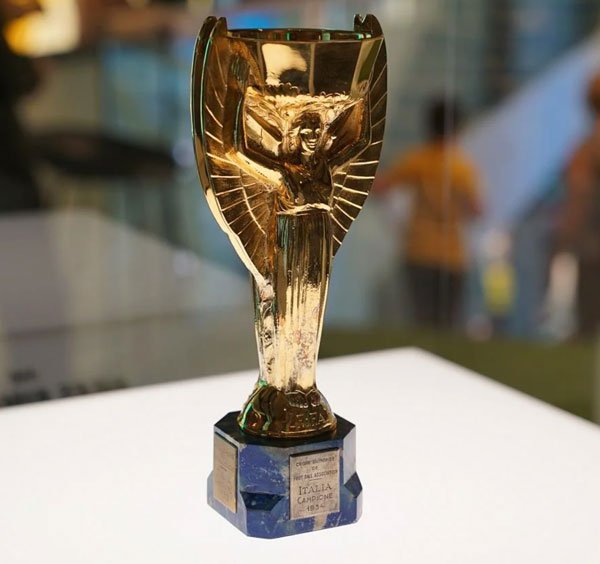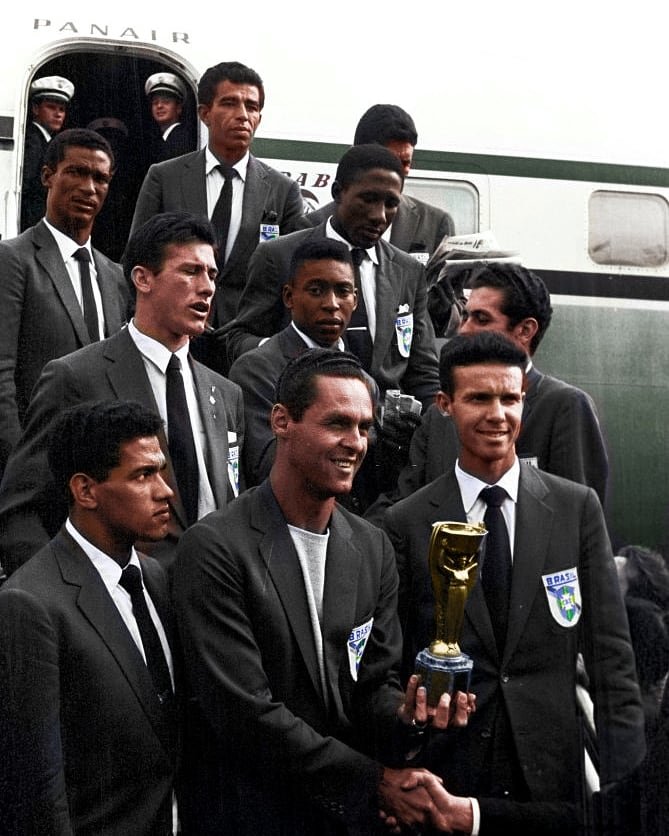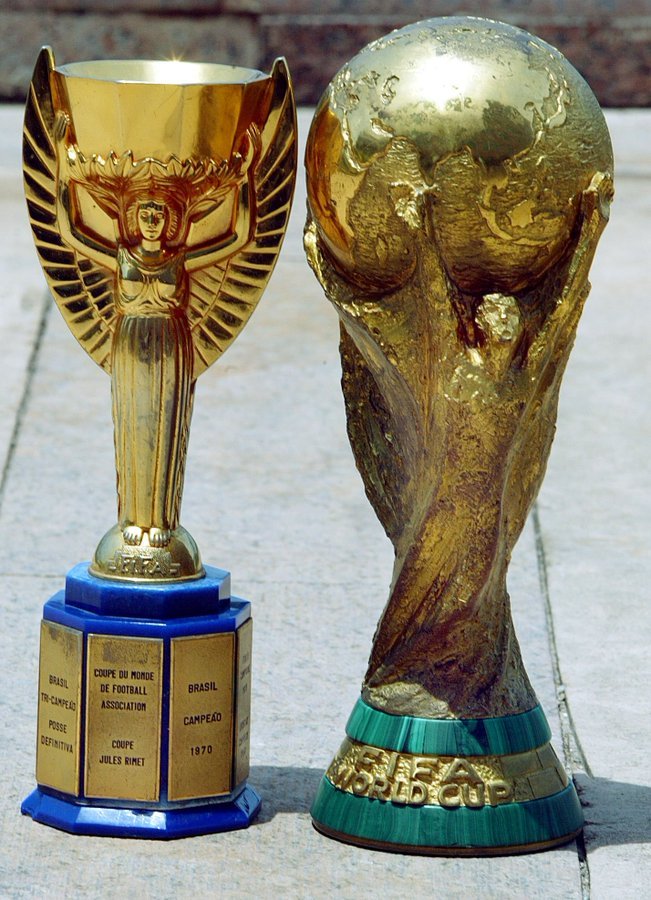
Imagen diseñada y asistida por ChatGPT
Historias, leyendas, alegrías y dramas, todo eso cabe en un pequeño trofeo de 30 centímetros de altura construido en plata esterlina y bañado en oro, montado sobre una base de lapislázuli.
El trofeo fue diseñado por el escultor francés Abel Lafleur allá por el año 1929 y se construyó por encargo de la FIFA y su presidente de aquel momento Jules Rimet para ser entregado al ganador del mundial de fútbol. El autor lo llamó "Diosa de la victoria" y su imagen es una alegoría de Niké, justamente la diosa de la mitología griega que representa la victoria.
Todos conocemos la parte entretenida y alegre de su historia, se entregó por primera vez a Uruguay, organizador y campeón del primer torneo mundial de fútbol; cada cuatro años se volvía a poner en juego, eso hasta que alguna selección nacional la obtuviera en 3 oportunidades, en ese momento el trofeo quedaría de manera permanente en poder del gran campeón. Eran las normas escritas.
En el año 1946 se cambió el nombre del trofeo por el de "Copa Jules Rimet" en homenaje al histórico presidente de la FIFA que ideó y organizó los campeonatos mundiales, con ese nuevo rótulo debutó en el mundial de 1950 disputado en Brasil donde se produjo un hecho sorprendente, se le llamó el Maracanazo y Uruguay se quedó con su segundo mundial relegando justamente a Brasil, gran candidato de todos.

Un primer hecho dramático que involucró al trofeo en cuestión ocurrió luego de que Italia ganara el mundial de 1938, al año siguiente estallaría la segunda conflagración mundial y los proyectados mundiales de 1942 y 1946 debieron suspenderse, la copa quedó a resguardo de los italianos por 10 años. Que no fuera incautada por los alemanes fue obra de Ottorino Barassi, por aquel entonces vicepresidente de la confederación de fútbol italiano que, previendo ese hecho, la escondió en su propia casa, tuvo razón y la sede de la confederación fue allanada al igual que las casas de sus directivos, por alguna razón no la encontraron, pese a que el escondite elegido fuera una caja de zapatos.
En 1966 y con motivo de la disputa de la copa del mundo en Inglaterra, el trofeo fue puesto en exhibición en el Central Hall Westminster de Londres, en los meses previos al inicio de la competencia. El 20 de marzo de ese año, entre las 11:00 y el mediodía, mientras en el primer piso se celebraba un acto religioso, un ladrón entró por la puerta trasera del edificio y salió sin dejar rastro llevándose la famosa copa. A una semana de ocurrido el hecho delictivo, el malhechor fue arrestado cuando quiso cobrar el rescate solicitado, pero la copa no aparecía. Unos días después y gracias al olfato de un perro, se la encontró en un parque envuelta el papel de periódico, sana y salva.
Corrió mucha agua bajo el puente del tiempo y en 1970 Brasil consiguió la hazaña de quedarse por tercera vez con el campeonato mundial, en esa oportunidad organizado por México, con ello obtuvo el derecho a conservar por siempre la obra de Lafleur, el trofeo en honor a Niké, la copa del mundo Jules Rimet.
Hazaña, alegría y leyenda. Nadie imaginaba lo que ocurriría unos años después.

El trofeo ganado en forma definitiva por Brasil estaba expuesto en la sede de la Confederación Brasileña de Fútbol y así permaneció hasta el año 1983, el 20 de diciembre de ese año, Sergio Pereyra Ayres, José Luiz Vieira da Silva y Francisco José Rocha Rivera ingresaron al noveno piso de la CBF, redujeron al guardia de seguridad y se llevaron la copa. Unos días después se la entregaron al joyero y reducidor, el argentino Juan Carlos Hernández. Todos fueron juzgados y condenados, aunque la pena máxima solo fue de 9 años para el cabecilla que cumplió 3 de forma efectiva.
La copa Jules Rimet jamás apareció y solo se conserva su base original de lapislázuli. Todo indica que fue reducida, aunque su historia final no acaba de concluir y existen teorías sobre la venta en el mercado negro.

Existen en la actualidad 3 réplicas reconocidas y vinculadas al trofeo original, una en poder de la propia FIFA, otra también propiedad de FIFA tiene una historia curiosa, otra más. Fue construida secretamente por la Federación Inglesa a poco de conocerse el robo de 1966 y para ser utilizada en caso de que la original no apareciera. En 1995 la FIFA la adquirió en una subasta, pero al comprobar que no era la original y que estaba hecha de bronce enchapado en oro, se la dio en calidad de préstamo al Museo Nacional del Fútbol inglés, donde permanece en la actualidad. La tercera y última se encuentra en poder de la Federación Brasileña de Fútbol, está construida con 1,8 kg. de oro macizo, fue creada por el joyero Rudolf Schaeffer y permanece en exhibición en el Museo de la Selección brasileña de Río de Janeiro, esta vez con medidas de seguridad acordes a la importancia simbólica y sentimental de la copa Jules Rimet.
Two robberies and an uncertain ending
Stories, legends, joys, and dramas, all of that fit into a small 30-centimeter-high trophy made of sterling silver and plated in gold, mounted on a lapis lazuli base.
The trophy was designed by the French sculptor Abel Lafleur back in 1929 and was built by order of FIFA and its president at that time Jules Rimet to be given to the winner of the World Cup. The author called it the "Goddess of Victory" and its image is an allegory of Nike, precisely the Greek goddess who represents victory.
We all know the entertaining and joyful part of its history; it was first given to Uruguay, organizer and champion of the first World Cup; every four years it was put back into play, that is until a national team won it on 3 occasions, at which time the trophy would remain permanently in the possession of the great champion. Those were the written rules.
In 1946, the trophy was renamed the "Jules Rimet Cup" in honor of the historic FIFA president who conceived and organized the world championships. It debuted under this new name at the 1950 World Cup in Brazil, where a surprising event took place: it was called the Maracanazo and Uruguay won its second World Cup, relegating Brazil, the leading contender.
The first dramatic event involving the trophy in question occurred after Italy won the 1938 World Cup. The following year, the Second World War broke out and the planned World Cups of 1942 and 1946 had to be suspended. The cup was kept in Italian custody for 10 years. The fact that it was not seized by the Germans was the work of Ottorino Barassi, then vice-president of the Italian football confederation, who, foreseeing this, hid it in his own house. He was right and the headquarters of the confederation were raided as well as the houses of its directors, but for some reason, they did not find it, although the chosen hiding place was a shoe box.
In 1966 on the occasion of the World Cup in England, the trophy was put on display in the Central Hall Westminster in London, in the months before the start of the competition. On March 20 of that year, between 11:00 and noon, while a religious ceremony was being held on the first floor, a thief entered through the back door of the building and left without a trace, taking the famous cup. A week after the crime occurred, the criminal was arrested when he tried to collect the requested ransom, but the cup was not found. A few days later, thanks to a dog's instinct, it was found in a park wrapped in newspaper, safe and sound.
Much water has flowed under the bridge of time and in 1970 Brazil achieved the feat of winning the world championship for the third time, on that occasion organized by Mexico, thereby obtaining the right to forever preserve the Lafleur work, the trophy in honor of Niké, the Jules Rimet World Cup.
A feat, joy, and legend. No one imagined what would happen a few years later.
The trophy, which Brazil had won definitively, was on display at the headquarters of the Brazilian Football Confederation and remained there until 1983. On December 20 of that year, Sergio Pereyra Ayres, José Luiz Vieira da Silva, and Francisco José Rocha Rivera entered the ninth floor of the CBF, subdued the security guard, and took the cup. A few days later they handed it over to the jeweler and reducer, the Argentine Juan Carlos Hernández. They were all tried and convicted, although the maximum sentence was only 9 years for the ringleader, who served 3 years.
The Jules Rimet Cup was never found and only its original lapis lazuli base remains. Everything indicates that it was reduced, although its final story is not over and there are theories about its sale on the black market.
There are currently 3 recognized replicas linked to the original trophy, one in the possession of FIFA itself, another also owned by FIFA has a curious history, and yet another. It was secretly built by the English Federation shortly after the theft in 1966 was known and to be used in case the original did not appear. In 1995 FIFA acquired it at an auction, but when it was discovered that it was not the original and made of gold-plated bronze, it was loaned to the English National Football Museum, where it remains today. The third and last one is in the possession of the Brazilian Football Federation and is made of 1.8 kg. Made of solid gold, jeweler Rudolf Schaeffer created it and remains on display at the Brazilian National Team Museum in Rio de Janeiro, this time with security measures in keeping with the symbolic and sentimental importance of the Jules Rimet Cup.
Héctor Gugliermo
@hosgug